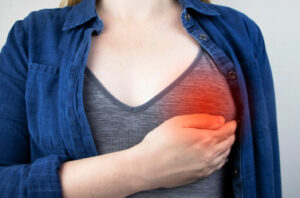Breast cancer is the second most common type of cancer, affecting 1 out of every 8 women in the U.S. alone. Additionally, 1 in every 39 women suffering from breast cancer dies, making it the most common cause of cancer-related deaths. However, this number can be reduced through early detection.
October is breast cancer awareness month, which calls for a comprehensive discussion on this topic.
read on to learn more.
What Is Breast Cancer?
Breast cancer is the result of the uncontrolled growth of breast cells. It occurs due to mutations or abnormal changes in the genes responsible for regulating the growth of breast cells.
According to the CDC, it is more common in women. However, 1 out of every 100 cases of breast cancer in the U.S affects a man. CDC further recommends regular checkups that can help with early detection, which saves lives.
Symptoms Of Breast Cancer
 Symptoms of breast cancer can vary from person to person, but here are some of the most common:
Symptoms of breast cancer can vary from person to person, but here are some of the most common:
- Painful breasts
- Visible changes in your breast size or shape
- Presence of a lumpy mass in the breast or in your armpit
- Swollen breasts
- Redness and flaking around the nipple area
- Nipple discharge, such as blood
- New lump in the breast or underarm (armpit)
Why Is Early Detection Important?
Early detection involves screening the breasts of at-risk people for any signs of cancer before they start to show any symptoms. It can help nip the disease in the bud and save lives before cancer progresses to an untreatable stage.
Here are some of the ways that can help diagnose it in its early stages:
- Breast self-exam or BSE
- Physical examination
- Screening tests such as a mammogram (Breast X-ray), breast ultrasound or breast MRI
7 Things To Prepare For Your Mammogram Appointment
Before going in for your mammogram appointment, be mindful of the following things:
1. Choose A Highly Skilled Professional.
Choose a highly trained radiologist with over 5 years of breast imaging experience. Moreover, try to be consistent with your appointments and always consult the same specialist to ensure a thorough comparison of previous scans with your most recent ones.
2. Bring Your Medical Documents Along With You.
If you’re consulting a specialist for the first time, make sure to bring all the documents from your previous mammograms and other pertinent documentation. These will pave the way for a quicker and more precise examination.
3. Avoid Booking An Appointment Just Before Your Period.
Usually, breasts feel a little more tender to touch just before your period begins, and this tenderness can be taken as a symptom. So, best not to set your mammogram appointment at this time.
4. Take Lots Of Fluids.
Drink plenty of fluids in advance as the hydration can help provide a better visual.
5. Wear Loose, Comfortable Clothes And Avoid Applying Cosmetic Products Before Going to Your Mammogram.
Wear loose, comfortable clothing that doesn’t cling to the skin because you will be asked to remove your top. It’s also best not to wear any makeup, perfume, deodorant, or other cosmetic products on the day of your appointment.
6. Discuss All Your Concerns With The Doctor.
Be honest about your recent health problems, prior surgeries, and family history of hormonal issues and breast cancer to get examined more effectively. Let them know if you have any physical difficulty standing or walking, or if you are pregnant or breastfeeding.
7. Avoid Caffeinated Products Before The Appointment.
Although caffeinated products do not affect your mammogram results directly, they can contribute to breast tenderness, which can cause more discomfort or pain during the procedure.
As cases of breast cancer are on the rise, it is important to educate ourselves and others who might be at risk.
This breast cancer awareness month, make sure to consider and spread awareness about early detection and help save lives.


